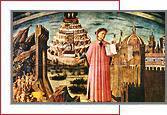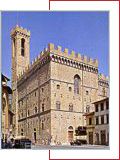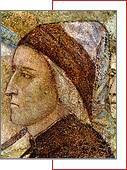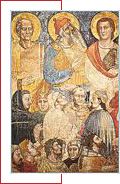The Florence of DANTE
back to itineraries in Florence
Dante Alighieri (Florence, 1265 - Ravenna, 1321) is universally known as the author of the Divine Comedy, a poem written in terza rima in the vernacular language of his time, divided into Inferno, Purgatorio and Paradiso. For its grandeur of construction, its power and variety of form, and its immense richness of expression, the Divine Comedy is acknowledged as one of the supreme masterpieces of world literature. In Florence we find buildings that were familiar to Dante, and works of art that celebrate his memory. |
|
|
This itinerary takes us through the heart of ancient Fiorentia,
starting from the Baptistery of San Giovanni, where Dante was
christened and where he hoped in vain to receive the poet's crown
he knew to be his due (Par. xxv, 1-9).
Inside the Cathedral there is a painting by Domenico di Michelino showing Dante illuminating Florence with his Poem (1465), and outside it there is the "Sasso di Dante", from which the poet is supposed to have observed the construction of the Cathedral (begun in 1296). From the Via Proconcolo we reach the Corso, site the old Porta San Piero, and pass the houses of the Portinari, where Dante's beloved Beatrice lived (cf. La Vita Nuova and Pur. xxx, 31-33). We continue beneath the arch of Via Santa Margherita and come first to Dante's Church and then to the so called "House of Dante", a small museum illustrating the poet's life and work. In the small square there is a marble plaque listing the monuments existing in Dante's day, such as the Torre della Castagna, used by the Priors of the Guilds, and the Badia, where the Marchese Ugo of Tuscany lies buried (cf. Par. xvi, 127-130). Nearby stands the imposing mass of the Palazzo del Bargello,
built in 1255 for the Captain of the People, and later used
as the castle of the Podestà. It was here that Dante's banishment
for Florence was proclaimed. In the chapel on the first floor,
a fresco attributed to Giotto has a portrait of Dante, standing
among the Elect in Paradise. We proceed eastwards towards the
Franciscan church of Santa Croce (1294), which has a large statue
of Dante (1865) by Enrico
Pezzi on the steps outside. |
|
|
We
continue along Borgo Santa Croce, with the old tower houses of
the Alberti, along Via de' Neri and Via della Ninna to the Palazzo
dei Priori (later known as Palazzo Vecchio, 1299), which stands
beside the Romanesque church of San Pier Scheraggio (later incorporated
into the Uffizi), where Dante took part in city assemblies.
The great open space of Piazza Signoria was recalled by Dante as the site of the houses of the Ghibelline Uberti, which were demolished after the triumph of the Guelfs. We proceed along the Chiasso Baroncelli, Via Lambertesca and Via Por Santa Maria (rebuilt after the second world war), and come to the Ponte Vecchio (1345). Nearby is the Tower of the Amidei, associated with the famous incident of the murder of Buondelmonte (cf. Par. xvi, 136). We walk westward along Borgo Santi Apostoli, passing the Piazzetta del Limbo with the church of the Santi Apostoli (11th century), and the Palazzo Spini (13th century), to reach the Piazza Santa Trinita. Inside the church of the same name, Dante would have known Cimabue's Madonna and Child, which is now in the Uffizi. By the Via Tornabuoni we reach the church of Santa Maria Maggiore, where Dante's teacher Brunetto Latini lies buried (cf. Inf. xv, 82-85). |
|
|
Finally we visit the church of Santa Maria Novella, to
admire the great Crucifix painted by Giotto, and the frescoes
by Nardo di Cione in the Strozzi Chapel, which show Paradise
and Hell
(1350-57) according to Dante's schemes. |
|
|
|
||
DOWNLOAD
Dante.pdf (35 kb)
back to itineraries in Florence








 German
German French
French Spanish
Spanish Italian
Italian Portuguese
Portuguese Czech
Czech Japanese
Japanese